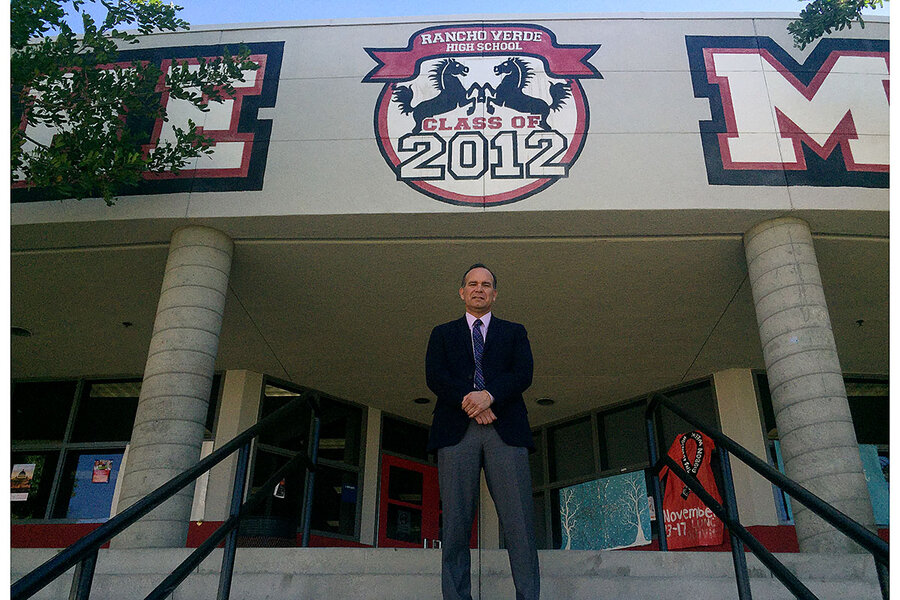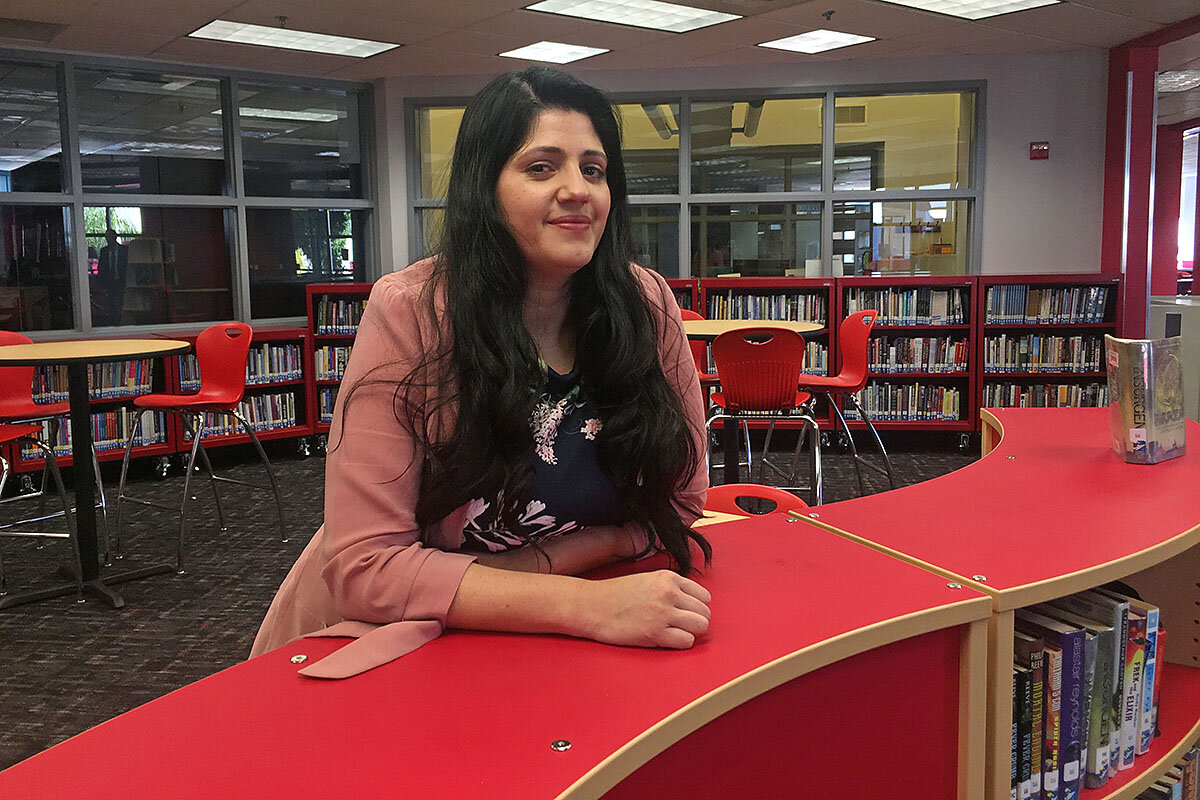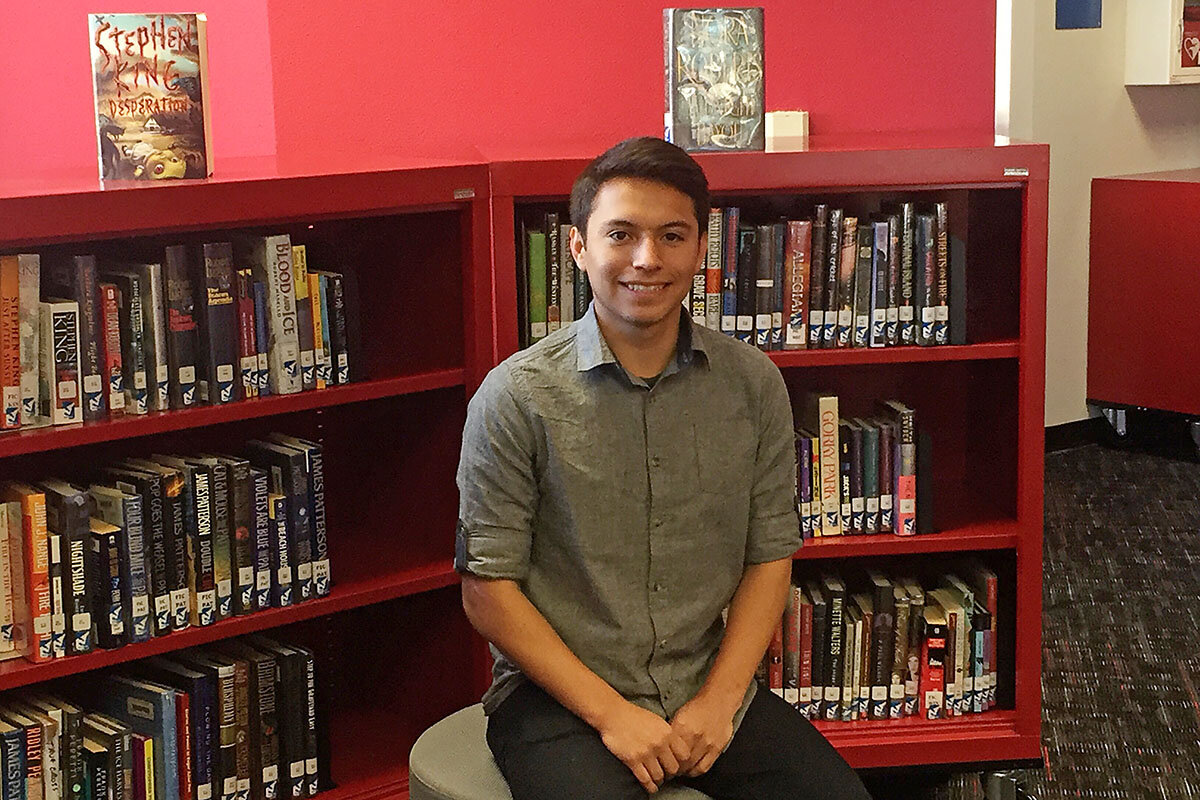In the race to help Latino students, one California county pulls ahead
Loading...
| Moreno Valley, Calif.
High school senior Raymond Franco made three mistakes on his college application.
They were little things, like putting “2017” instead of “2018” as his graduation year. They probably wouldn’t have made a dent in his chances at getting into his schools of choice – the 17-year-old takes three advanced placement classes and trains with three different sports teams.
Then again, Mr. Franco says, maybe they would have. “If you mess up on one thing, it can mess up your whole application,” he says.
Which is why he was thankful that Rancho Verde High School devoted several class periods this fall to helping students fill out college and financial aid applications. Faculty and counselors were present to answer questions, explain requirements, and – as in Franco’s case – spot errors. For Franco, whose parents have little experience with college, having hands-on support in class was crucial.
“It was really helpful having the teachers there,” he says. “They check off everything.”
The push to provide direct assistance to high school seniors applying for college is one small slice of Riverside County’s efforts to help students prepare for, enroll in, and ultimately graduate from college. Since 2014 the county has also expanded student access to college counselors, improved parent engagement and bilingual services, and helped students fill out the Free Application for Federal Student Aid (FAFSA). As a result, graduation rates, college enrollment, and FAFSA completion are up across the county. This year the California Student Aid Commission took Riverside County’s FAFSA completion challenge, called “Race to Submit,” and implemented it statewide.
County leaders say the secret is in relying on rigorous data collection and analysis to identify and address the actual needs of its students and families. In their case, that meant adapting to a student population that is two-thirds Latino and 63 percent eligible for free and reduced lunch.
It’s a strategy that education advocates say could serve as an important model for chipping away at a broader issue: improving outcomes for California’s Latino students, who despite making up the majority of the state’s student population, still face some of the greatest barriers to college enrollment and completion for any demographic, according to a report released last month.
“We often ask [students and families] to navigate a system not designed for them, instead of meeting students where they’re at,” says Ryan Smith, director of Education Trust-West, the nonprofit behind the report. “We haven’t faced the reality that this state will succeed or not succeed by the way it treats its Latino students.”
Similar stories across California
In some ways Franco’s story echoes that of millions of other Latino students across California. His parents are both Mexican immigrants – and according to Education Trust-West, about 80 percent of the state’s Latino youth are of Mexican heritage. Neither attained a bachelor’s degree, which puts them with about 90 percent of Latinos age 25 and over. Their combined annual income, meant to support a household of seven, is just under $50,000. Among all ethnic groups Latino students “are the most likely to be low-income while in college,” Education Trust reports.
But Franco’s current circumstances aren’t the sole arbiters of his future. “The data is an indictment of the system we’ve created, not a reflection of the students and families in this state,” Mr. Smith says.
In 2014, Riverside County set out to prove it. Armed with a $1.7 million grant from the Bill and Melinda Gates Foundation, county officials formed the Riverside County Education Collaborative (RCEC) – a coalition of local district leaders, school counselors, representatives from regional colleges, and other community stakeholders. Its goals include raising FAFSA completion from 52 to 93 percent, boosting post-secondary enrollment from 52 to 65 percent, and improving college readiness using metrics provided by both the state university and community college systems.
They aim to hit those targets by June 2019 – in a region that has the lowest degree-attainment level among adults for a metro area its size.
They began with the numbers. The county asked all 23 districts to sign a data-sharing agreement that would give the RCEC leadership access to student transcripts and other information. Riverside is also a leader in the use of the National Student Clearinghouse service that tracks postsecondary enrollment, attendance, and performance for up to seven years after a student graduates from high school. The county pays to have all its high schools subscribe to the service.
The data showed them not only which students were struggling, but how, and where they needed more support. “We’re looking at every transcript, finding out what are the obstacles and barriers that are getting in their way,” says Mark LeNoir, assistant superintendent of education services for Val Verde Unified School District, which includes schools in Moreno Valley and Perris, Calif. “We felt that if we’re going to move forward, we’re going to have to look at things through the lens of systems.”
For instance, Mr. LeNoir says they found that many students couldn’t turn to their parents – who had never been to college – when filling out FAFSA and college application forms and figuring out exactly what the course requirements were for state university systems. But there also weren’t enough school counselors who were trained to answer students’ questions about those issues. So RCEC developed a counselor network that focuses on professional development and college and career training.
Today 500 counselors across the county are part of the network – the biggest such network in the state. And not only is morale up among local counselors, who typically feel overworked and undervalued, but they’re also more invested in student success, says Robin Ellison, a school counselor at Rancho Verde.
“Just to have the support, and have people see value in the work that we do, is huge for us,” she says. “That FAFSA push is something that counselors take personal now.”
Getting comfortable with data
Numbers proved when Riverside was doing it right: like when the county’s graduation rate shot up to 89 percent in 2016, making it second only to Orange County among the state’s largest counties. Or when its countywide completion rate for state university courses rose from 28 to 44 percent between 2010 and 2016. Or when 90 percent of the 2017 graduating class at Val Verde Unified successfully completed their FAFSA and California Dream Act applications, the highest rate for any school district in the nation.
But often school leaders would come into the monthly RCEC meetings with high hopes for a program they’d implemented, only to be crushed by how little they’d moved the needle.
“The difficult piece was getting comfortable with the data, when … we didn’t get the gains we expected,” says RCEC director Catalina Cifuentes. “The challenge was getting to the point where we were OK with saying, ‘We’re doing great things, but we’re not there yet.’ ”
Still, RCEC leaders say that the most important takeaway of their experiment so far is how changing systems also helps change attitudes – and vice versa. “Half of the battle is when you can get your districts to believe that the students can do it,” says Judy White, superintendent for Riverside County.
“This is a great example that if given the right support and assistance, those students will meet the expectations,” adds Smith at Education Trust. “It shows that students can achieve.”
For his part, Franco believes. The Rancho Verde student almost bristles with excitement when he talks about his AP statistics classes, the engineering courses he wants to take in college, the grants and scholarships he’s got lined up, the solar panels he hopes to someday build himself. “Technology’s booming, and there's just a bunch of stuff you can do,” he says, grinning. “I want to be a part of that.”










